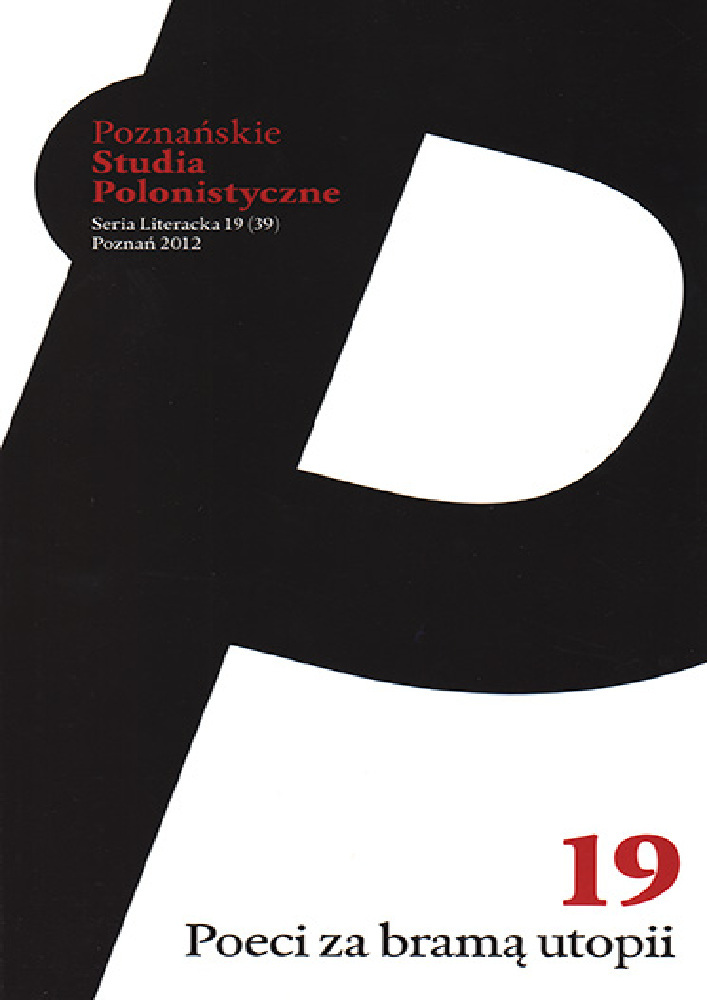Abstrakt
The article attempts to reveal a reconstruction of Piotr Chmielowski’s critical thought regarding the poetical works written by Adam Asnyk (pen-name E...ly). The starting point for the discussion is a set of variations for different editions of Zarys literatury polskiej as well as other works of the critic elucidating the specificity, importance and the character of the poetry of E…ly. The article attempts to show why it was just the figure of the poet that was necessary and constituted a model figure for revealing the attempts of saving continuance of not only Polish poetry but also national culture and heritage. In his critical reflection, Chmielowski tries to find continuity between the Romantic paradigm and the post-January insurgency paradigm that was to define the obligations and the status of poetry, as well as to identify, uphold important question for Chmielowski himself as to why it was necessary to find among the generation of post-insurgency Poles a figure that would resemble Ignacy Kraszewski, a man-institution, and thus provide an exemplary model, necessary and much needed model figure in upholding and maintaining national consciousness and in preserving continuity. It is the culture and literature of the latter half of the nineteenth century that Chmielowski investigates in search of poetry and the poet as an icon of the nineteenth centuryness and modernity in the post-January insurgency non-poetical times. Asnyk can be seen, in Chmielowski’s terms, as an icon of the modern poet, a keystone figure who straddled the line between what can be consolidated and what was left to be saved in order to preserve the paradigm of Romantic poeticalness and the necessity for adjusting to new cultural circumstances and contemporary expectations on the part of receivers.Bibliografia
Baczewski A., Twórczość Adama Asnyka, Rzeszów 1984.
Chmielowski P., Geneza fantazji, w: idem, Pisma krytycznoliterackie, t. 1, oprac. H. Markiewicz, Warszawa 1961.
Chmielowski P., Historia literatury polskiej, t. 6, Warszawa 1900.
Chmielowski P., Metodyka historii literatury polskiej, Warszawa 1899.
Chmielowski P., Poezja w wychowaniu, Wilno 1881.
Chmielowski P., Pogląd na poezję polską w pierwszej połowie XIX stulecia. Studia i szkice z dziejów literatury polskiej, t. 2, Kraków 1886.
Chmielowski P., Przedmowa, w: idem, Zarys literatury polskiej z ostatnich lat szesnastu, Wilno 1881.
Chmielowski P., Przedmowa, w: idem, Zarys najnowszej literatury polskiej (1864–1894), Kraków–Petersburg 1895.
Chmielowski P., Zarys najnowszej literatury polskiej (1864–1894), Kraków–Petersburg 1895.
Grzędzielska M., [hasło] PARNAS, w: Słownik literatury polskiej XIX wieku, red. J. Bachórz i A. Kowalczykowa, Wrocław 2009.
Lichański S., „Polscy parnasiści”, „Twórczość” 1962, nr 6.
Mazur A., Parnasizm w poezji polskiej drugiej połowy XIX i początku XX wieku, Opole 1993.
Mocarska-Tycowa Z., Wybory i konieczności. Poezja Asnyka wobec gustów estetycznych i najważniejszych pytań swoich czasów, Toruń 1990.
Nofer-Ładyka A., O Asnyku – rocznicowo, „Polonistyka” 1978, nr 2.
Paczoska E., Krytyka literacka pozytywistów, Wrocław 1988.
Licencja
Autorzy
Autorzy tekstów przyjętych do publikacji w czasopiśmie „Poznańskie Studia Polonistyczne. Seria Literacka” są zobowiązani do wypełnienia, podpisania i odesłania na adres redakcji umowy o udzielenie nieodpłatnej licencji do utworów, z zobowiązaniem do udzielania sublicencji CC.
Zgodnie z umową, autorzy tekstów opublikowanych w czasopiśmie „Poznańskie Studia Polonistyczne. Seria Literacka” udzielają Uniwersytetowi im. Adama Mickiewicza w Poznaniu niewyłącznej i nieodpłatnej licencji oraz zezwalają na użycie sublicencji Creative Commons Attribution-NoDerivatives 4.0 International (CC BY-ND 4.0).
Autorzy zachowują prawa do dalszego, swobodnego rozporządzania utworem.
Użytkownicy
Zainteresowani użytkownicy internetu uprawnieni są do korzystania z utworów opublikowanych od 2016 roku w „Poznańskich Studiach Polonistycznych. Serii Literackiej” pod następującymi warunkami:
- uznanie autorstwa – obowiązek podania wraz z rozpowszechnionym utworem, informacji, o autorstwie, tytule, źródle (odnośniki do oryginalnego utworu, DOI) oraz samej licencji;
- bez tworzenia utworów zależnych – utwór musi być zachowany w oryginalnej postaci, nie można bez zgody twórcy rozpowszechniać np. tłumaczeń, opracowań.
Do wszystkich tekstów opublikowanych przed 2016 r. prawa autorskie są zastrzeżone.
Inne
Uniwersytet im. Adama Mickiewicza w Poznaniu zachowuje prawo do czasopisma jako całości (układ, forma graficzna, tytuł, projekt okładki, logo itp.).
